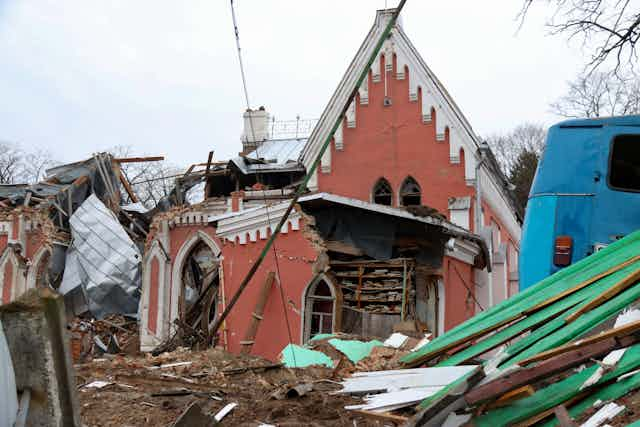Destruction of Ukrainian heritage is happening on a scale not seen there since World War II, a report published by the journal, Antiquity, has claimed.
The report lists damage to a number of historic sites, including the Unesco-listed Vasyl Tarnovsky Museum of Ukrainian Antiquities and the burial mound at Boldyni Hory – one of the largest eleventh-century Ukrainian necropolises. Since the war began, Unesco has verified damage to 329 sites, including to the historic centre of Chernihiv.
It adds that collections have been expropriated and transferred to Russia from museums in occupied regions, including Kherson (now back under Ukrainian control), Melitopol and Mariupol, while in other cases artefacts have been pillaged by Russian soldiers to keep or sell. Researchers are using satellite data as well as on-the-ground assessments to document the destruction of Ukraine’s cultural heritage.
It was damage to heritage during World War II that prompted the United Nations to put together the Convention for the Protection of Cultural Property in the Event of Armed Conflict (also known as the 1954 Hague convention). This made it a war crime to destroy “cultural property” (the term used to describe tangible heritage) except in cases of military necessity.
The 1954 convention envisaged a scheme for the protection of heritage in war that would parallel schemes for the protection of people. Like the red cross emblem that effectively removes things such as ambulances and hospitals from the danger of attack, there was to be an emblem, a blue and white shield, that should create awareness (and protection) of important museums, monuments, archaeological sites, archives and libraries.
An additional protocol proposed that there be an organisation, The Blue Shield), to protect cultural heritage in emergency situations.
Although this got off to a relatively slow start. The UK ratified the convention in 2017 – the last major military power to do so. The convention mandates states to have “cultural protection units” as part of the regular armed forces – the UK set one up in 2019. The prompt for this activity was the widespread destruction of heritage in the Middle East, notably parts of Palmyra in Syria by ISIS and the destruction of the Mosul Museum in Iraq.
The west has its own sins to count here: during the invasion of Iraq, the Americans set up a large military base on the site of Ancient Babylon and did extensive damage including using thousands of tons of archaeological material to fill sandbags.
Despite all this, as the report on Ukraine makes clear, there are limits to what can be achieved. Part of the problem is that it is just difficult to persuade armies to be careful about buildings when they are shooting and/or being shot at. Despite signing up, states have not really put much effort into implementing the convention.
There are few sites marked with the blue and white shield in the world, and it is not obvious that it would help them much if they were marked with the shield. (I have one of the shields upstairs – a despairing member of The Blue Shield gave it to me as a keepsake). There are some commendable efforts to train regular soldiers in the heritage legislation, but they have a lot of other calls on their attention.

Although Ukrainians will survive this loss it is, nonetheless, a loss. Sometimes this is tangible; a ruined town bereft of history is unlikely to attract tourists and revenue. Sometimes it is less tangible. Links with the past are destroyed, there is a loss of opportunity to continue a way of life, to live in the place one’s parents and grandparents lived, to go to the same church or even the same cafe. When these things are gone we can never get them back.
Other countries have tried to replace what had been destroyed. The Poles, for example, reconstructed the historic centre of Warsaw, which had been levelled by the Nazis.
But what people want is history, not a copy of history. Also, by that stage, there might be other demands on scarce resources – as Lynn Meskell, professor of anthropology at Penn State University has argued, sometimes we need toilets first and temples second.
Why protect buildings?
It would be optimistic to think the Russians were worrying too much about the Hague convention (although they, like the Ukrainians, are signatories). However, if they were, the uncertainties at its heart would not help. For the past few years, Helen Frowe, director of the Stockholm Centre for the Ethics of War and Peace, and I have been trying to clarify matters. Central to these issues are the “stones versus lives” debate: given limited resources, should we focus on preserving culture (stones) or people (lives)?
The standard reply to this is that concern for heritage and concern for people are inseparable. Thomas G. Weiss and Nina Connelly, cultural heritage experts based at the City University of New York, have gone as far as to set out how an expansion of the “responsibility to protect” legislation may justify the case that it is right to go to war to prevent heritage being destroyed.
Frowe and I take a different view. We do not think choices between heritage and people can generally be avoided.
Earlier I said that the Hague convention outlaws the destruction of cultural property except in cases of military necessity, where there’s “no feasible alternative available to obtain a similar military advantage” (Article 6). But is an alternative feasible if it saves the cultural property, but increases the risk to soldiers by 5%? What about 10%? Without some way of making such calculations, the convention is toothless.
Artefacts that have been around for a thousand years or more have been destroyed in Russia’s illegal war. However, facing up to the issues, which includes improving this international legal structure, might help prevent some destruction of cultural treasures in the future.

